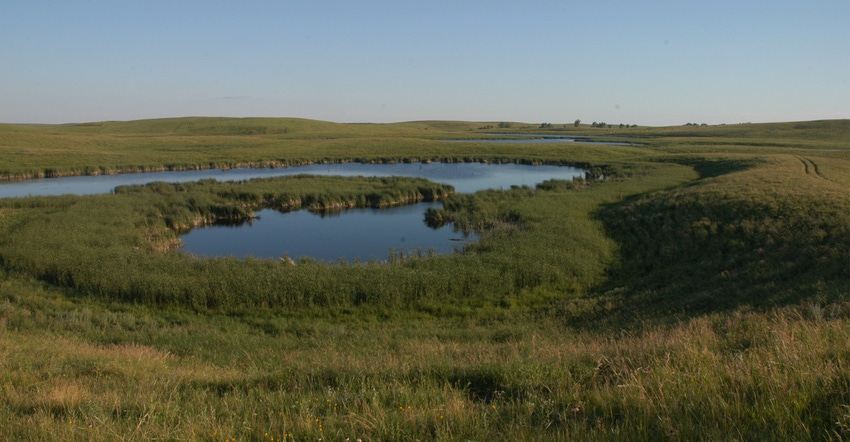Conditions set stage for poor water quality
Lack of precipitation heightens the need to test quality of water in ponds, dugouts and dams before livestock graze land.

If drought conditions linger, water’s value as a resource will be even further reinforced. The quantity of water is not only critical, but also its quality, especially for livestock, says cow-calf specialist Robin Salverson.
Salverson, who works at the South Dakota State University Extension regional center in Lemmon, says surface water supplies this spring in South Dakota may be more at risk for quality issues than in years past. “Last fall kind of set us up for that situation, along with the winter,” she says. “We were dry last fall, and then the winter we had limited snow, which didn’t flush out any of our surface waters.”
That sets the stage for poor water quality, a situation that may only get worse if drought conditions persist. Water supplies are not being replenished, and the water that is there is disappearing due to evaporation exacerbated by the spring winds.
Water quality can influence production in livestock, as she says you may notice calves coming off the grass at the end of the year lighter weight than anticipated. Poor-quality water consumed during breeding season can also have reproductive implications, such as “more opens or they get bred later in the calving season,” she says. In extreme cases, death may occur.
Test early
Symptoms can come on quickly, so Salverson urges ranchers to sample and test water sources that will be available to livestock before turning the animals loose for summer grazing. Water can be tested in a few ways:
Laboratories. There are laboratories that will provide a complete analysis of water samples, for which ranchers will need to collect, package and send samples away.
Extension. Considering that symptoms can appear in a day or two, Salverson recommends bringing water samples to a regional or county Extension office where personnel should be able to perform a quick electrical conductivity test free of charge.
Veterinarians. She also suggests veterinarians or nutritionists may offer water testing as a service to clients.
EC meters. Ranchers also have the option of buying their own electrical conductivity meters, which start at around $60.
An EC quick test detects total dissolved solids, and Salverson says levels above 3,000 parts per million are cause for concern and should trigger further water testing. Ranchers witnessing cattle experiencing “blind staggers” may be seeing the symptoms of polio, brought on by high levels of sulfur in the water, and meter readings over 3,500 ppm may provide a good indicator.
Salverson says polio in livestock has become common in western South Dakota over the past several years. “If you’ve ever seen animals out in your pasture or in a neighbor’s pasture starting to look like they have blind staggers, they start to kind of circle, or you may see them off on their own, if you don’t catch them soon enough, they will actually go down and start flailing,” she says. If given the opportunity, you may see an animal with polio pressing their head against a railroad tie or fence post, “to try to relieve pressure off their brain.”
If caught early, Salverson says effects of polio are reversable, stressing the importance of regularly observing your herd as well as reaching out to your veterinarian to aid in diagnosis. While Salverson encourages ranchers to test drinking water sources early, they also need to be aware that blue-green algae can become a problem later in summer, and ranchers may not be aware of its presence until animals start dying.
One good thing is that blue-green algae usually disappears “fairly quickly and the toxin no longer has an effect on your animals, but it is something else that you need to be aware of this summer,” she says.
Solutions to poor-quality water
Ranchers faced with poor quality water do have options, such as moving livestock to a different pasture after checking the water quality there. Salverson says it’s important to check every source of water for purity, as it can vary from water hole to water hole, even within the same pasture. She has also heard of ranchers bringing in water to either create a new water source or to dilute a problematic existing water source.
Even though tests are the best way to indicate water quality, Salverson says observing animal behavior can also indicate something is amiss. “If your cows are trying to go back to where they came from, it’s a good sign your water is bad,” she says. “If your animals are trying to get through the gates or through the fences, and just trying to get back to where they were, it a good indication the water’s not good.”
Contrary to what one might think, Salverson says typically the clearer the water appears, the poorer the quality. “Usually because if it’s nice and clear, that means frogs and fish and bugs can’t live in it,” she says, “because of the total salts that are in there. Typically, the murkier the water is probably better than clearer water.”
Even though the current forecast points to a droughty summer, Salverson stresses poor-quality water is not isolated to only dry years. “Water is obviously the most important nutrient to an animal, but it’s one that we rarely are concerned about,” she says, “but we should be.”
About the Author(s)
You May Also Like



